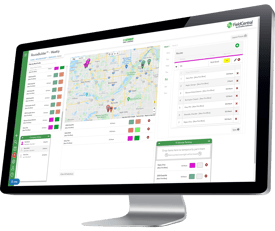.png?width=750&name=Lesson%20From%20The%202020%20Green%20Industry%20Benchmark%20Report%20(2).png)
This is the final post of a three part series on our 2020 Green Industry Benchmark Report. Read: Part I and Part II.
7. Goal-setting matters
Let’s get back to important stuff: sports. One of my fondest memories as a football fan growing up in Minnesota was Herschel Walker’s first game with the Vikings. The Vikings, thinking they were a good running back away from a championship team, traded away what turned out to be four players and 8 draft picks for Walker (picks that eventually led to the Cowboys’ early 1990s dynasty). In that first game, it looked like a genius move, as he rushed for almost 150 yards.
But more important to this story is the story of Herschel Walker. As a young child, Walker had a speech impediment, was short and chubby, and was bullied and beat up by his classmates in elementary school. No one could have predicted he’d go on to be one of the best running backs in the history of football.
Except Walker. He set a simple goal - he wanted to be better at sports. And with a single-minded purpose, he set about figuring out to do that. He asked a track coach and the coach said “It’s simple, but you have to work hard. Do sit-ups, push-ups and sprints.” And Walker did, turning his life around.
You might say “Well, yeah, but it was all the hard work that made Walker the athlete he became.” That’s true. But it all started with a simple goal - to get better at sports. Then he created a strategy to do that. And then executed that strategy. That goal-setting mattered.
It also matters to your green industry business. According to the Green Industry Benchmark Report, goal-setting seems to matter. Businesses that grew were generally more likely to set goals than their counterparts whose growth stayed the same or declined, a result we’ve found in many Benchmark Reports. In fact, each year it looks like the businesses that grow the fastest are also more likely to set long-term goals than their slower-growing counterparts.
How do you set goals? Here are some tips:
1. Spend a day planning with your management team what your long term goals are. A lot of business books tell you to start with an outrageous goal 10 years in the future. Then, work backwards from that goal to set 5, 3, 1 and quarterly goals.
A lot of businesses set annual goals, but many of them don’t set quarterly goals that help them achieve those annual goals. So they probably aren’t adjusting their strategy half-way through the year if they’ve missed their quarterly goals because they don’t have quarterly goals that roll up to the annual.
2. Always communicate your goals with your team. For example, if you want to increase your customer satisfaction as measured by a customer satisfaction survey, create a scorecard that you review at every team meeting that shows your overall satisfaction and the customers that have lower satisfaction.
It takes repetition for most people to understand your goals and then take action based on them. So always communicating with them helps reinforce the importance of a goal. If you create a goal and only talk about it a couple times a year, people won’t think it’s all that important. Build that communication into your meeting rhythm.
3. Make sure everyone has a number that helps you achieve your goal. For example, one of our customers uses Revenue per hour as the primary number for a field employee. He wants them to hit a certain threshold. So if they take their time getting parts from the distributor or take a long lunch, their revenue per hour could go down because they aren’t being productive during that time.
And when their manager reviews their revenue per hour, he’ll dig into why they weren’t productive and take corrective measures. By giving everyone a number, you’re setting their daily expectations. And by aligning that number with a business goal, you’re helping your business achieve better results.
8. Maximize your labor investment
We integrate with a GPS solution that enables customers to put a device in their trucks and track where their crews/technicians are, how fast they’re travelling, how long they’ve idled, maintenance records and more.
When one of our customers first installed the software, they had a customer complain that they had been billed for an hour of work, but the technician had only been there for five minutes. They checked their GPS log and were shocked to find the customer was correct.Their technician had gone to a park for 55 minutes and was only at the customer’s property for 5 minutes.
We saw earlier that the average green industry business spends about 40% of their revenue on wages. Additionally, the Green Industry Benchmark Report shows that - at least early this year when they were surveyed - the typical green industry business not only expects to add employees, but it also expects to raise prices because of higher labor costs. So it’s vital that businesses maximize that labor investment, especially in what was a tight labor market.
Here are some tips on how to maximize your labor investment in a green industry business:
1. Measure everything. If you want to maximize your employees’ productivity, you have to start by measuring what they do and how long it takes to do it. So track how long they’re in the shop, how long they’re driving, how long each type of job takes, and how long they take for lunch. With that data, you can examine ways to optimize each employees’ day. You can’t improve what you don’t measure.
2. Ask your employees. It’s also important that you ask your employees how you can help them get more work done. I’d create a list of their suggestions and then put together a plan to address the ones that will increase productivity the most.
3. Document your Processes. Another way to improve productivity is to document your core business processes. By going through the effort to document those processes, you’ll likely find ways to streamline them and squeeze more profitability out of each of your employees.
4. Train. Finally, if you’ve measured, documented and gotten feedback from your employees, it’s time to train employees on new processes and techniques you’ve uncovered that will maximize your productivity. You may find this is easier to do in a group setting, though I’d review any individual suggestions one-on-one with your employees.
9. Delegate
Richard Branson credits his dyslexia as a child for helping him build a number of iconic, billion dollar businesses. Why? According to an interview with Bloomberg, Branson said it helped him learn to delegate.
“If you have a learning disability, you become a very good delegator. Because you know what your weaknesses are and you know what your strengths are, and you make sure that you find great people to step in and deal with your weaknesses. And actually, whether you are dyslexic or not, I think delegation is such an important thing for a good leader to be good at doing. Too many leaders want to cling onto everything themselves and do everything themselves and never let go. Therefore, they never grow a group of companies like Virgin.”
That advice is well taken given the results from our Green Industry Benchmark Report. Delegation seems to lead to better business results. Consider that:
Of the businesses that saw revenue growth in excess of 20% last year, about 27% had more than 1 full-time sales rep. Compare that to those whose revenue stayed the same, where just 8% had more than 1 sales rep, and it appears that having dedicated sales reps can help you improve your ability to grow rapidly.
The same holds true for office managers. Of businesses that didn’t grow, about 33% had no office manager, much more than 24% of total businesses surveyed that don’t have an office manager.
Now, obviously, some businesses aren’t in a position to hire sales reps or office managers. But as soon as you’re financially able to do so, it’d be a good strategy.
Here are some other tips on how to delegate in your green industry business
Right people, right seats. In order to delegate in your business, you first need to hire well. We follow the Entrepreneurial Operating System (EOS) as outlined in the book, Traction, and it’s one of the key tenets. Not only do you need the right people - people that have your company’s core values and that have the capacity and willingness to do the job. But you also need to put them in positions where they can succeed. A common thing I see at green industry businesses is that they make their best technicians or crew members team leaders or managers. Leadership and management skills are much different than being able to diagnose and fix an irrigation system. So making that person a team leader or manager may not be a good fit for them.
Know your strengths and weaknesses. When you hire, try to find people that aren’t like you. Nobody is perfect. You have your own strengths and weaknesses. You want to find people that make up for your shortcomings. For example, if you’re strong at selling, but not great at coaching and leading a team, find someone that’s great at leadership and growing a team.
Know your team. When delegating, you also need to know the strengths of your team so you’re assigning tasks to people who are most likely to complete them well. It will also help you determine what kind of coaching or training you’ll need to provide when you delegate to your team.
Don’t micromanage. Finally, people learn best by failing. Don’t be afraid to let your employees fail and learn from their mistakes. If you micromanage delegated tasks, you really haven’t delegated them - and you’ll probably alienate your employees. Instead, when completed, have a postmortem and have your employee determine what worked or what didn’t work so they learn from what they’ve done (or not done.)
10. The software you choose matters
In 1999, candy giant Hershey’s installed a new order taking system that was a combination of software from SAP, Siebel and Manugistics. Unfortunately, Hershey’s had issues implementing that software solution which kept Hershey’s from delivering nearly $100 million dollars worth of Hershey’s Kisses and Jolly Ranchers for Halloween. As a result, their stock price fell more than 8% and analysts didn’t fully trust Hershey’s to deliver candy until the following fall, tarnishing the company’s image and delaying increases in their stock.
Choosing the wrong software can have consequences. Just like you wouldn’t use a shovel to dig a subway tunnel, you can’t expect accounting platforms like QuickBooks to manage the data flow throughout your operational processes.
Nowhere is that more apparent than in the green industry. Most of the leading software solutions in the green industry got their start in specific segments. For example, Service Autopilot was conceived in their owner’s lawn care business. Same with Clip. LMN was born out of a landscaping business. Those businesses have different processes and as a result the software solutions have different core functionalities. LMN, for example, focuses heavily on estimating. So if you’re looking to be more efficient operationally, it’s not going to be the best solution for your business.
The Green Industry Benchmark Report backs that up. Not only does it show that the leveraging software will lead to better outcomes - faster revenue growth and higher profitability - but HindSite customers were also more likely to report better revenue growth and profitability numbers than their peers using other software.
So it’s clear that choosing the right software is important. Just like you wouldn’t use a shovel to dig a subway tunnel, you shouldn’t expect estimating software to lead to faster revenue growth. So when shopping for software, here are some tips:
1. Know what issue you’re trying to solve. Different software solutions address different issues better. For example, if you’re looking to improve scheduling and routing, we have tools that make that easier and enable you to schedule more jobs every day by creating tighter routes. If you’re looking to create landscape designs, there’s great CAD software for that. By understanding and articulating what issue you most want to solve, you’ll be better able to target your software search.
2. Installation is a process. Understand that installing software - especially something like HindSite that is more like a business operating system than an app - is a process, not an event. The first conversation we have when a new customer orders is to create a roadmap for implementing the software over time.
Companies that try to do everything at once – Scheduling, routing, field data collection, inventory management, fleet management – tend to get bogged down by too much new information and change. We always try to get companies to start small. Get the system setup, then get one technician or crew up and running for a week or two and slowly add more techs and crews. Then repeat with other divisions as necessary. A phased approach ensures a better experience.
3. Look for a partner, not a software provider. I like to use Google products as an example. I love their products – Gmail, Sheets, etc. I even signed up for their phone network, Google Fi. Their software is excellent. Their support is not. We’ve found that most green industry businesses are not the most tech-savvy. They’re great at doing the work in the field and serving customers. They don’t spend a lot of time with software.
That’s why we’ve got a team of support and training professionals that offer unlimited training. Most people get wowed by software – and I know, especially in the lawn care industry, there are a lot of free or nearly free providers out there. That means they’re likely either charging extra for support or not really supporting the product at all. You’ll realize how important support is when your software goes down in the middle of the day and there’s no one to talk to that can help fix it.








